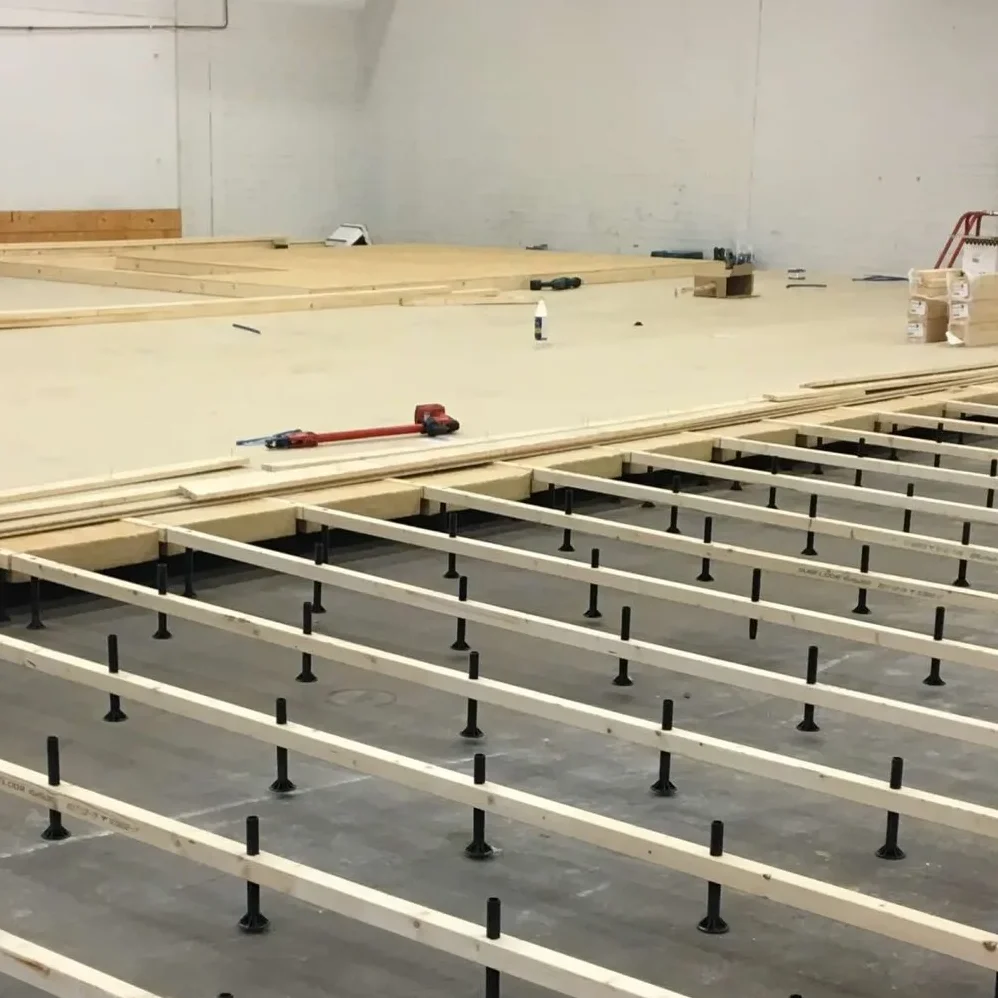- October 28, 2024
To remove glue from a subfloor, use a combination of mechanical scraping, heat application, and chemical adhesive removers.
Removing glue from a subfloor can be a daunting task. It requires patience and the right approach. However, having the proper tools at your disposal can significantly simplify the process and make it more efficient. Whether dealing with stubborn adhesive left behind from old flooring or preparing a surface for a new installation, the right tools can make all the difference. We’ll break down the essential tools to tackle glue removal from your subfloor. Let’s explore the must-haves for a successful removal from scrapers and heat guns to safety gear.
Essential Tools for Removing Glue from Subfloor
Removing glue from a subfloor can be a challenge. But having the right tools at your disposal can make the task much easier and more efficient. Here’s a breakdown of the essential tools you need to have before removing glue from your subfloor.
Floor Scraper or Putty Knife
Purpose:
These are your primary tools for mechanical removal. A floor scraper has a wide blade that allows you to lift and scrape off larger areas of glue, while a putty knife can be useful for detailed work and getting into corners.
Recommendation:
Choose a heavy-duty scraper for tough adhesives. A long-handled scraper can reduce strain on your back and arms.
Heat Gun
Purpose:
Use a heat gun to soften the glue. This makes it easier to scrape off. The heat loosens the adhesive bond, allowing you to lift it away more easily.
Recommendation:
Look for a heat gun with adjustable temperature settings. This will give you better control depending on the type of glue you are dealing with.
Chemical Adhesive Remover
Purpose:
These solvents are designed to break down specific types of adhesives, making them easier to remove. They can be useful for stubborn or thick glue residues.
Recommendation:
Choose a remover compatible with the type of glue you’re working with. Always read the label for safety and application instructions.
Shop Vacuum
Purpose:
A shop vacuum is essential for cleanup after the glue removal process. It helps you quickly and effectively collect debris, dust, and leftover adhesive particles.
Recommendation:
Opt for a vacuum with a strong suction and a filter to handle fine dust and particles.
Broom and Dustpan
Purpose:
These collect larger pieces of debris, that can not be vacuumed. A broom can also help sweep away dust and particles after scraping.
Recommendation:
Choose a sturdy broom with stiff bristles for effective cleaning.
Safety Gear
Purpose:
Safety gear protects you from hazards associated with glue removal, such as sharp tools and harmful chemicals.
Essentials:
- Gloves: To protect your hands from chemicals and sharp edges.
- Goggles: To shield your eyes from dust and debris.
- Mask: To prevent inhalation of fumes and dust particles.
Additional Tools
- Chisel: A chisel can be helpful for more stubborn adhesives, particularly cement-based types.
- Diamond Grinder: A diamond grinder can effectively remove thick adhesive layers for heavy-duty removal, especially on concrete subfloors.
Essential Techniques for Removing Glue from Subfloor
Here are some essential techniques to help you remove adhesive from your subfloor.
Mechanical Scraping
Technique:
- Start with a Floor Scraper: Use a heavy-duty floor scraper or putty knife to lift and scrape off the bulk of the glue. Hold the scraper at a low angle to maximize leverage.
- Work in Sections: Focus on small sections, applying consistent pressure to lift the glue.
Tips:
- A long-handled scraper can help reduce strain on your back.
- Keep the blade sharp to make scraping easier.
Heat Application
Technique:
- Use a Heat Gun: Hold a heat gun a few inches above the glue and move it in a circular motion to distribute heat. This will soften the adhesive, making it easier to scrape off.
- Test the Temperature: Start with a lower temperature and gradually increase it as needed, avoiding damage to the subfloor.
Tips:
- Be cautious around sensitive materials, as excessive heat can cause warping or damage.
- Always test in a small area first to assess how the subfloor reacts to heat.
Chemical Adhesive Removal
Technique:
- Apply a Chemical Remover: Choose a solvent compatible with the type of glue. Apply it generously to the affected area and allow it to sit for the recommended time.
- Scrape After Soaking: Use your scraper to lift the glue after the adhesive is soft.
Tips:
- Ensure good ventilation when using chemical removers, as fumes can be harmful.
- Always follow the manufacturer’s instructions for application and safety precautions.
Combination Method
Technique:
- Combine Heat and Chemical Removers: For particularly stubborn glue, use a heat gun to soften the adhesive, followed by a chemical remover to break it down further.
- Layer Your Approach: Start with mechanical scraping. Then apply heat, and finish with a chemical remover as needed.
Tips:
- This method can be more time-efficient and effective for tough adhesives.
- Don’t overheat the area when using both methods together.
Final Cleaning
Technique:
- Vacuum Up Debris: After removing the glue, use a shop vacuum to clean up any dust and leftover adhesive particles.
- Wipe Down the Area: Use a damp cloth to wipe down the surface, removing any remaining chemical residues or dust.
Tips:
- Make sure the area is dry before proceeding with any new flooring installation.
- Inspect the subfloor for any remaining glue and address it as needed.
9 Things You Need to Know Before Removing Glue from Subfloor
Removing glue from a subfloor can involve various tools and materials, some of which may pose risks if proper precautions aren’t taken. Here are essential safety tips.
Wear Protective Gear
Essentials:
- Gloves: Use chemical-resistant gloves to protect your hands from solvents and sharp tools.
- Goggles: Safety goggles shield your eyes from dust, debris, and splashes from chemical removers.
- Mask: A dust mask or respirator protects you from inhaling harmful fumes and fine particles, especially when using chemical products or power tools.
Ensure Good Ventilation
- Open Windows: Keep windows open to allow fresh air to circulate.
- Use Fans: Set up fans to promote airflow. It is essential when working with chemical adhesives that emit fumes. This helps reduce the concentration of harmful vapors.
Read Labels and Instructions
- Follow Manufacturer Guidelines: Read the instructions on chemical products and tools. This includes proper usage, safety precautions, and necessary first aid measures.
Test Products in a Small Area
- Patch Test: Before applying any chemical remover or heat to the area, test it in a small, inconspicuous spot. This ensures that the method will not damage the subfloor and allows you to observe any adverse reactions.
Handle Tools Carefully
- Use Sharp Tools Safely: When using scrapers, knives, or chisels, cut away from your body to minimize the risk of injury.
- Be Mindful of Electrical Tools: If using a heat gun or grinder, ensure that cords are in good condition and keep them away from water or damp areas.
Keep the Area Organized
- Clear the Workspace: Remove obstacles and clutter from your work area to prevent tripping hazards.
- Secure Loose Items: Make sure all tools and materials are stored safely when not in use to avoid accidents.
Store Chemicals Properly
- Follow Storage Guidelines: Keep chemicals in their original containers with labels intact, and store them in a cool, dry place away from direct sunlight and out of reach of children and pets.
- Dispose of Waste Correctly: Follow local regulations for disposing of used chemical products and glue residues.
Stay Aware of Your Surroundings
- Work in a Well-Lit Area: Ensure adequate lighting to see your workspace and avoid accidents.
- Take Breaks: If you’re feeling fatigued, take breaks to prevent lapses in attention that could lead to accidents.
Have a First Aid Kit Handy
- Be Prepared for Emergencies: Keep a first aid kit nearby in case of minor injuries. Familiarize yourself with basic first aid procedures in case of accidents.
Types of Floor and Their Glue Cleaning Methods
When removing glue from flooring, the type of floor significantly influences the cleaning method. Adhesives adhere differently to various surfaces, and using the right approach can save you time and effort. Here’s a breakdown of common flooring types and the best methods for cleaning glue from each.
Vinyl Flooring
Glue Types
- Mastic
- Pressure-sensitive adhesive
Cleaning Methods
- Mechanical Scraping: Use a floor scraper or putty knife to remove as much glue as possible.
- Chemical Adhesive Remover: Apply a solvent designed for vinyl. It will dissolve the adhesive. Ensure it’s safe for vinyl.
- Heat Gun: Use a heat gun to soften the glue before scraping, but keep it at a distance to prevent damage.
Carpet
Glue Types
- Contact adhesive
- Carpet adhesive mastic
Cleaning Methods
- Heat Application: Use a heat gun or steam cleaner. It will soften the glue. This can make it easier to peel off the carpet backing.
- Chemical Solvent: Apply a solvent designed for carpet adhesive. Follow the manufacturer’s instructions for application and dwell time.
- Scraping: Once the subfloor is soft, use a scraper. It lifts the adhesive from the subfloor.
Tile Flooring
Glue Types
- Cement-based adhesive
- Thin-set mortar
Cleaning Methods
- Mechanical Removal: A chisel or floor scraper may be necessary to chip away cement-based adhesives.
- Diamond Grinder: Use a diamond grinding tool. It can effectively remove residue for stubborn adhesive.
- Water: Sometimes, dampening the area can help loosen the adhesive for easier removal.
Glue Types
- PVA glue
- Pressure-sensitive adhesive
Cleaning Methods
- Scraping: Begin with a scraper to remove the bulk of the glue.
- Chemical Remover: Use a solvent designed for laminate, being careful to avoid excessive moisture, which can damage the material.
- Heat Gun: Lightly apply heat to soften the adhesive before scraping.
Wood Flooring
Glue Types
- Urethane adhesive
- PVA glue
Cleaning Methods
- Mechanical Scraping: A sharp floor scraper removes glue without damaging the wood.
- Solvent: Use a solvent suitable for wood that can dissolve the adhesive. Test in an inconspicuous area first.
- Heat Application: Carefully use a heat gun to soften the glue, then scrape away.
Concrete Flooring
Glue Types
- Epoxy
- Mastic
Cleaning Methods
- Diamond Grinding: A diamond grinder is often the most effective for tough adhesives like epoxy.
- Chemical Solvent: Apply an appropriate solvent to break down the glue, allowing easier scraping.
- Scraping and Chiseling: Use a heavy-duty scraper or chisel for manual removal, especially for thicker residues.
Comparison of Various Types of Glue Removal Methods
Here’s a comparative table summarizing various glue removal methods, their effectiveness, and potential drawbacks. Each method is rated on a scale from 1 to 5, with 1 being the least effective or most challenging and 5 being the most effective or easiest.
Removal Method | Effectiveness (1-5) | Tools Required | Time Efficiency (1-5) | Safety Concerns |
Mechanical Scraping | 4 | Floor scraper, putty knife | 3 | Low |
Heat Application | 4 | Heat Gun | 4 | Moderate (heat risks) |
Chemical Adhesive Remover | 5 | Chemical remover, scraper | 4 | High (Fume exposure) |
Diamond Grinding | 5 | Diamond grinder | 3 | High (dust exposure) |
Chiseling | 3 | Chisel, hammer | 2 | Moderate (sharp tools) |
Steam Cleaning | 4 | Steam Cleaner | 4 | Low (water risk) |
Conclusion
Removing glue from a subfloor doesn’t have to be an overwhelming task. By understanding the types of glue and appropriate removal methods, you can streamline the process and prepare your subfloor for its new finish. Remember to prioritize safety and follow best practices to ensure the best results. With the right tools and knowledge, you’ll have a clean and ready subfloor in no time!
If you’re ready to tackle your flooring project and need expert guidance, look no further than Elephant Floors! Our knowledgeable team is here to help you choose the right flooring solutions and provide tips for a seamless installation. Whether you’re removing glue, selecting new materials, or seeking professional assistance, we’ve got you covered.
Visit Elephant Floors today to explore our range of flooring options and resources! Let’s make your flooring dreams a reality!




